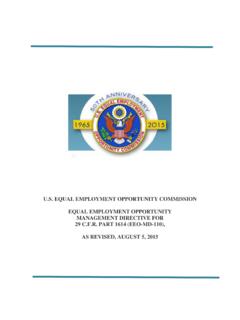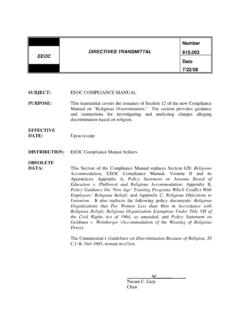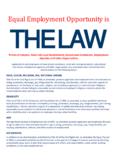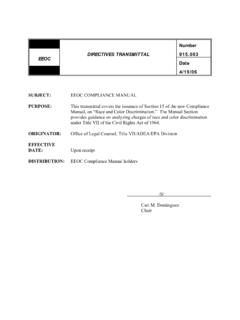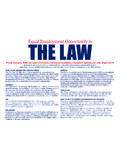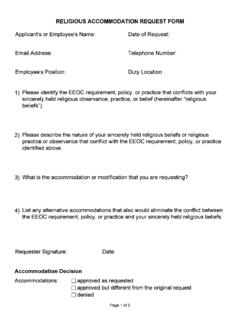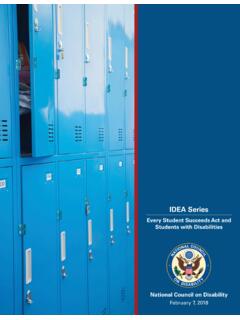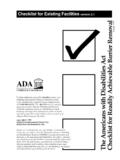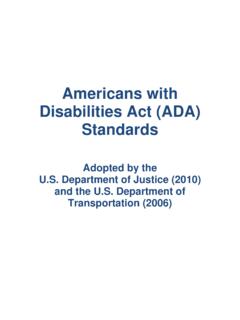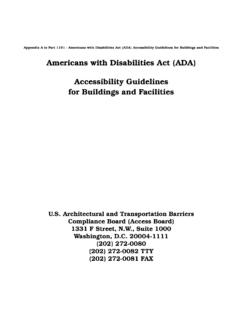Transcription of PANDEMIC PREPAREDNESS IN THE WORKPLACE AND …
1 1 PANDEMIC PREPAREDNESS IN THE WORKPLACE AND THE americans with disabilities act UPDATED IN RESPONSE TO COVID-19 PANDEMIC March 19, 2020 This guidance document was issued upon approval of the Chair of the Equal Employment Opportunity Commission. OLC Control # EEOC-NVTA-2009-3 Title PANDEMIC PREPAREDNESS in the WORKPLACE and the americans with disabilities act Date Issued Originally 09-Oct-09; revised 19-Mar-20 General Topics ADA/GINA Summary This document provides information about the ADA and PANDEMIC planning in the WORKPLACE . Date Posted Originally 09-Oct-09; revised 19-Mar-20 Statutes/Authorities Involved ADA, Rehabilitation Act, 29 CFR Part 1630 Audience Health Care Providers, Employees, Employers, Applicants, HR Practitioners Revision The document was updated on March 19, 2020 to add examples and information regarding the COVID-19 PANDEMIC . The contents of this document do not have the force and effect of law and are not meant to bind the public in any way.
2 This document is intended only to provide clarity to the public regarding existing requirements under the law. NOTE ABOUT MARCH 19, 2020 UPDATE: The EEOC is updating this 2009 publication to address its application to coronavirus disease 2019 (COVID-19). Employers and employees should follow guidance from the Centers for Disease Control and Prevention (CDC) as well as state/local public health authorities on how best to slow the spread of this disease and protect workers, customers, clients, and the general public. The ADA and the Rehabilitation Act do not interfere with employers following advice from the CDC and other public health authorities on appropriate steps to take relating to the WORKPLACE . This update retains the principles from the 2009 document but incorporates new 2 information to respond to current employer questions. For readers ease the COVID-19 updates are all in bold.
3 I. INTRODUCTORY INFORMATION A. PURPOSE This technical assistance document provides information about Titles I and V of the americans with disabilities act (ADA) and Section 501 of the Rehabilitation Act and PANDEMIC planning in the WORKPLACE .(1) This document was originally issued in 2009, during the spread of H1N1 virus, and has been re-issued on March 19, 2020, to incorporate updates regarding the COVID-19 PANDEMIC . It identifies established ADA principles that are relevant to questions frequently asked about WORKPLACE PANDEMIC planning such as: How much information may an employer request from an employee who calls in sick, in order to protect the rest of its workforce when an influenza PANDEMIC appears imminent? When may an ADA-covered employer take the body temperature of employees during a PANDEMIC ? Does the ADA allow employers to require employees to stay home if they have symptoms of the PANDEMIC influenza virus?
4 When employees return to work, does the ADA allow employers to require doctors notes certifying their fitness for duty? In one instance, to provide a complete answer, this document provides information about religious accommodation and Title VII of the Civil Rights Act of 1964. B. BACKGROUND INFORMATION ABOUT PANDEMIC INFLUENZA A PANDEMIC is a global epidemic. (2) The world has seen five influenza pandemics in the last century. The deadly Spanish Flu of 1918 was followed by the milder Asian and Hong Kong flus of the 1950s and 1960s. While the SARS outbreak in 2003 was considered a PANDEMIC scare, (3) the H1N1 outbreak in 2009 rose to the level of a PANDEMIC .(4) On March 11, 2020, COVID-19 was declared a PANDEMIC . The Department of Health and Human Services (HHS), Centers for Disease Control and Prevention (CDC), and the World Health Organization (WHO) are the definitive sources of information about influenza pandemics.
5 The WHO decides when to declare a PANDEMIC and it classifies PANDEMIC influenza into six phases(5) which describe how widely influenza is spreading around the world, but not the severity of the influenza symptoms. A WHO announcement that the world is in PANDEMIC Phase 6 (the highest phase) would indicate that there is sustained human-to-human transmission worldwide, and that the virus is no longer contained in a few geographic areas. It would not, however, automatically mean that the influenza symptoms are severe. PANDEMIC planning and PANDEMIC PREPAREDNESS include everything from global and national public health strategies to an individual employer s plan about how to continue operations. Comprehensive federal government guidance advises employers about best practices for 3 PANDEMIC preparation and response with respect to influenza, specifically the 2009 H1N1 virus and COVID-19.
6 (6) This EEOC technical assistance document focuses on implementing these strategies in a manner that is consistent with the ADA and with current CDC and state/local guidance for keeping workplaces safe during the COVID-19 PANDEMIC . This document recognizes that guidance from public health authorities will change as the COVID-19 situation evolves. II. RELEVANT ADA REQUIREMENTS AND STANDARDS The ADA, which protects applicants and employees from disability discrimination, is relevant to PANDEMIC preparation in at least three major ways. First, the ADA regulates employers disability-related inquiries and medical examinations for all applicants and employees, including those who do not have ADA disabilities .(7) Second, the ADA prohibits covered employers from excluding individuals with disabilities from the WORKPLACE for health or safety reasons unless they pose a direct threat ( a significant risk of substantial harm even with reasonable accommodation).
7 (8) Third, the ADA requires reasonable accommodations for individuals with disabilities (absent undue hardship) during a PANDEMIC .(9) This section summarizes these ADA provisions. The subsequent sections answer frequently asked questions about how they apply during an influenza PANDEMIC . The answers are based on existing EEOC guidance regarding disability-related inquiries and medical examinations, direct threat, and reasonable accommodation.(10) A. DISABILITY-RELATED INQUIRIES AND MEDICAL EXAMINATIONS The ADA prohibits an employer from making disability-related inquiries and requiring medical examinations of employees, except under limited circumstances, as set forth below.(11) 1. Definitions: Disability-Related Inquiries and Medical Examinations An inquiry is disability-related if it is likely to elicit information about a disability.(12) For example, asking an individual if his immune system is compromised is a disability-related inquiry because a weak or compromised immune system can be closely associated with conditions such as cancer or HIV/AIDS.
8 (13) By contrast, an inquiry is not disability-related if it is not likely to elicit information about a disability. For example, asking an individual about symptoms of a cold or the seasonal flu is not likely to elicit information about a disability. A medical examination is a procedure or test that seeks information about an individual s physical or mental impairments or health.(14) Whether a procedure is a medical examination under the ADA is determined by considering factors such as whether the test involves the use of medical equipment; whether it is invasive; whether it is designed to reveal the existence of a physical or mental impairment; and whether it is given or interpreted by a medical professional. 2. ADA Standards for Disability-Related Inquiries and Medical Examinations 4 The ADA regulates disability-related inquiries and medical examinations in the following ways: Before a conditional offer of employment: The ADA prohibits employers from making disability-related inquiries and conducting medical examinations of applicants before a conditional offer of employment is made.
9 (15) After a conditional offer of employment, but before an individual begins working: The ADA permits employers to make disability-related inquiries and conduct medical examinations if all entering employees in the same job category are subject to the same inquiries and examinations.(16) NOTE: New questions 16-19 below address specific questions about hiring during the COVID-19 PANDEMIC . During employment: The ADA prohibits employee disability-related inquiries or medical examinations unless they are job-related and consistent with business necessity. Generally, a disability-related inquiry or medical examination of an employee is job-related and consistent with business necessity when an employer has a reasonable belief, based on objective evidence, that: An employee s ability to perform essential job functions will be impaired by a medical condition; or An employee will pose a direct threat due to a medical condition.
10 (17) This reasonable belief must be based on objective evidence obtained, or reasonably available to the employer, prior to making a disability-related inquiry or requiring a medical examination. (18) All information about applicants or employees obtained through disability-related inquiries or medical examinations must be kept confidential.(19) Information regarding the medical condition or history of an employee must be collected and maintained on separate forms and in separate medical files and be treated as a confidential medical record. B. DIRECT THREAT A direct threat is a significant risk of substantial harm to the health or safety of the individual or others that cannot be eliminated or reduced by reasonable accommodation. (20) If an individual with a disability poses a direct threat despite reasonable accommodation, he or she is not protected by the nondiscrimination provisions of the ADA.
